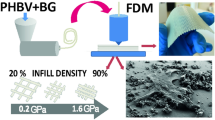Abstract—A standard series of ceramic scaffolds for bone tissue regeneration with Kelvin architecture was developed, providing matrix water permeability not less than 900 Darcy and relative rigidity of matrices of not more than 0.2. The possibility of producing bioceramic scaffolds is shown using stereolithographic 3D printing of light-cured slurries containing a mixed calcium sodium phosphate Ca2.5Na(PO4)2 composition. A production technology of bioceramic scaffolds is developed and tested, including the development of photocurable slurries; 3D printing modes are also worked out, as well as conditions of heat treatment of printed models and sintering. The proposed methods of stereolithography formation followed by heat treatment of printed models make it possible to produce ceramic scaffolds with lateral resolution no worse than 50 μm and 50 μm layering. The dimensions of the bioceramic scaffold differ from the reference dimensions of the initial model by no more than 10%; the degree of macroporosity is not less than 70% and the pore size is 500 μm. It is shown that the obtained bioceramic scaffolds are compatible with the human fibroblast cell culture, are not cytotoxic, do not contain components inhibiting fibroblast adhesion, spreading, and proliferation, and can be used in tissue engineering.




Similar content being viewed by others
REFERENCES
Burchardt, H., The biology of bone graft repair, Clin. Orthop., 1983, vol. 174, pp. 28–42.
Urist, M.R., Bone: formation by autoinduction, Science, 1965, vol. 150, pp. 893–899.
Reddi, A.H., Morphogenesis and tissue engineering of bone and cartilage: inductive signals, stem cells, and biomimetic biomaterials, Tissue Eng., 2000, vol. 6, pp. 351–359.
Ripamonti, U., Biomimetism, biomimetic matrices and the induction of bone formation, J. Cell. Mol. Med., 2009, vol. 13, no. 9, pp. 2953–2972.
Denrya, I. and Kuhn, L.T., Design and characterization of calcium phosphate ceramic scaffolds for bone tissue engineering, Dental Mater., 2016, vol. 32, no. 1, pp. 43–53.
Barinov, S.M. and Komlev, V.S., Biokeramika na osnove fosfatov kal’tsiya (Calcium Phosphate Bioceramics), Moscow: Nauka, 2005.
Putlyaev, V.I. and Safronova, T.V., A new generation of calcium phosphate biomaterials: The role of phase and chemical compositions, Glass Ceram., 2006, vol. 63, nos. 3–4, pp. 99–102.
Safronova, T.V. and Putlyaev, V.I., Inorganic materials science in medicine of Russia: calcium phosphate materials, Nanosist.: Fiz., Khim., Mat., 2013, vol. 4, no. 1, pp. 24–47.
Hing, K.A., Bioceramic bone graft substitutes: Influence of porosity and chemistry, Int. J. Appl. Ceram. Technol., 2005, vol. 2, no. 3, pp. 184–199.
Klawitter, J.J., Bagwell, J.G., Weinstein, A.M., and Sauer, B.W., An evaluation of bone growth into porous high density polyethylene, J. Biomed. Mater. Res., 1976, vol. 10, no. 2, pp. 311–323.
Eggli, P.S., Müller, W., and Schenk, R.K., Porous hydroxyapatite and tricalcium phosphate cylinders with two different pore size ranges implanted in the cancellous bone of rabbits, Clin. Orthop. Rel. Res., 1988, vol. 232, pp. 127–137.
Karageorgiou, V. and Kaplan, D., Porosity of 3D biomaterial scaffolds and osteogenesis, Biomaterials, 2005, vol. 26, pp. 5474–5491.
Ievlev, V.M., Putlyaev, V.I., Safronova, T.V., and Evdokimov, P.V., Additive technologies for making highly permeable inorganic materials with tailored morphological architectonics for medicine, Inorg. Mater., 2015, vol. 51, no. 13, pp. 1295–1313.
Putlyaev, V.I., Evdokimov, P.V., Safronova, T.V., Klimashina, E.S., and Orlov, N.K., Fabrication of osteoconductive Ca3 – xM2x (PO4)2 (M = Na, K) calcium phosphate bioceramics by stereolithographic 3D printing, Inorg. Mater., 2017, vol. 53, no. 5, pp. 529–535.
Evdokimov, P.V., Putlyaev, V.I., Ivanov, V.K., Garshev, A.V., Shatalova, T.B., Orlov, N.K., Klima-shina, E.S., and Safronova, T.V., Phase equilibria in the tricalcium phosphate-mixed calcium sodium (potassium) phosphate systems, Russ. J. Inorg. Chem., 2014, vol. 59, no. 11, pp. 1219–1227.
Orlov, N.K., Putlyaev, V.I., Evdokimov, P.V., Safronova, T.V., Klimashina, E.S., and Milkin, P.A., Resorption of Ca3 – xM2x(PO4)2 (M = Na, K) calcium phosphate bioceramics in model solutions, Inorg. Mater., 2018, vol. 54, no. 5, pp. 500–508.
GOST (State Standard) ISO 10993-5-2011: Medical Devices, Biological Evaluation of Medical Devices, Part 5: Tests for in vitro Cytotoxicity, Moscow: Standartinform, 2013.
Sander, E.A. and Nauman, E.A., Permeability of musculoskeletal tissues and scaffolding materials: experimental results and theoretical predictions, Crit. Rev. Biomed. Eng., 2003, vol. 31, nos. 1–2, pp. 1–26.
ACKNOWLEDGMENTS
Assisitance of Dr. I.I. Selezneva and A.A. Tikhonov in cell culture experiments is deeply appreciated.
Author information
Authors and Affiliations
Corresponding author
Ethics declarations
The study was performed within the framework of the State Program of the Russian Federation “Healthcare Development” (state contract no. 47.001.18.0 of May 31, 2018) and the research agreement no. 258/18 between the Department of Chemistry of the Moscow State University and the Experimental Production Workshops of the Federal Medical and Biological Agency of Russia.
Additional information
Translated by A. Kolemesin
Rights and permissions
About this article
Cite this article
Putlyaev, V.I., Yevdokimov, P.V., Mamonov, S.A. et al. Stereolithographic 3D Printing of Bioceramic Scaffolds of a Given Shape and Architecture for Bone Tissue Regeneration. Inorg. Mater. Appl. Res. 10, 1101–1108 (2019). https://doi.org/10.1134/S2075113319050277
Received:
Revised:
Accepted:
Published:
Issue Date:
DOI: https://doi.org/10.1134/S2075113319050277



